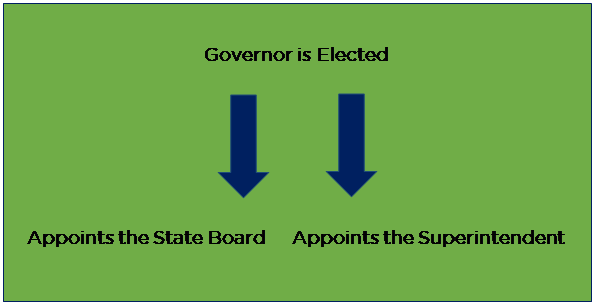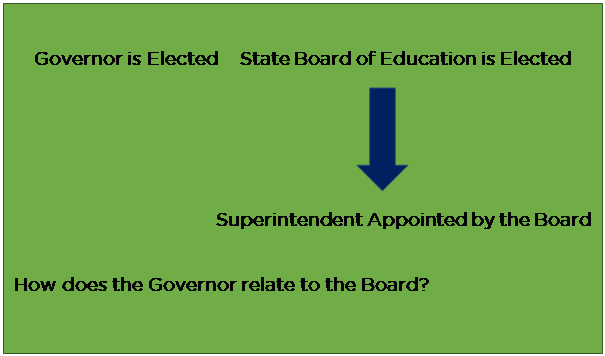The Alabama Legislature is currently considering a bill that would potentially overhaul state education governance and policymaking as it relates to K—12 public schools in the state. The bill, which has already passed the Senate, would abolish the elected State Board of Education and the Board-appointed position of State Superintendent of Education. The bill would create a Governor-appointed Commission, the Alabama Commission on Elementary and Secondary Education. The Commission would appoint a Secretary of Elementary and Secondary Education to be approved by the Senate. If approved by the Legislature, the proposal will be placed on the statewide ballot as an amendment to the Alabama Constitution.
State commissions or boards of education and chief executive officers, whether they be superintendents or secretaries are central to state education governance. The process used for their selection has implications for accountability, decision-making, and setting priorities for a state’s K—12 education system.
All but two states (Minnesota and Missouri) have a school board or commission. Eleven states have elected school boards (12 if including the district of Columbia). The rest have appointed boards, most of which are appointed by the governor. States with elected school boards or commissions are listed below.
States with Elected Boards
- Alabama
- Colorado
- Kansas
- Louisiana
- Michigan
- Nebraska
- New Mexico – only an advisory group
- Nevada – Mixture of elected and appointed members
- Ohio
- Texas
- Utah
The proposal before the Legislature resembles the governance structure currently in place in 12 states in which the governor appoints the school board and the board appoints the superintendent.
Education Governance
Why does this matter? States have the responsibility for implementing federal education law and developing, implementing, and managing state-level policies. For this to work well, several institutions must work well together.
State legislatures must pass effective legislation.
Governors can propose education legislation and have the statutory authority to approve or veto legislation. As the state’s chief executive, the governor carries out the laws passed by the legislature. They can also play an important role in shaping the priorities of a state board when they have the power to appoint. In some states, as in Alabama, the governor serves as president of the school board.
State boards of education are responsible for statewide curriculum standards; high school graduation requirements; qualifications for professional education personnel; state accountability and assessment programs; standards for accreditation of local school districts; preparation programs for teachers and administrators; administration of federal assistance programs; and the development of rules and regulations for the administration of state programs. State boards are often seen as the lay representative of the state’s population and as the liaison between professional educators and policymakers. Boards should play a role as advocates for education and, in some states, have been influential in building consensus on state education policy.[1]
Finally, state superintendents are responsible for administrative oversight of state education agencies and implementation of state law and board policies. Policy making can occur as superintendents interpret laws and policies they are responsible for implementing.
A report issued by the Education Commission of the States (ECS) outlines how state boards and state superintendents are chosen in varying states, and how the majority of states fall into one of four models. These models, described below, have implications for how state leaders work together in setting priorities and implementing policies.[2]
Model 1: Governor Appoints Board
and Superintendent
In 10 states (Delaware, Iowa, Maine, New Hampshire, New Jersey, Pennsylvania, South Dakota, Tennessee, Vermont, and Virginia), the governor has the most power in setting priorities and ensuring they are implemented.

Consequently, the superintendent and board should both be aligned with the governor, though the superintendent may feel more independent of the board than in other models where the board appoints them. The governor is accountable to the voters and can be held more directly accountable for the status and effectiveness of education in the state
Model 2: Governor Appoints Board and Board Appoints Superintendent
In 12 states (Alaska, Arkansas, Connecticut, Florida, Hawaii, Illinois, Kentucky, Maryland, Massachusetts, Missouri, Rhode Island, and West Virginia), the governor still has power in shaping the education agenda but has less direct control over the implementation of policies through the superintendent’s office, as compared to Model 1. The Board and Superintendent would potentially have a closer relationship than found in Model 1. The proposed Commission in Alabama fits this model.

Model 3: Governor Appoints Board while Superintendent is Elected
In 10 states (Arizona, California, Georgia, Idaho, Indiana, Montana, North Carolina, North Dakota, Oklahoma, and Wyoming), voters may see different platforms for education supported by the governor and the superintendent. The governor appoints the board, and this becomes a channel through which policy is formed. The superintendent may exercise more autonomy in interpreting those policies and how they will be implemented in the state.

Model 4: Board is Elected and Appoints the Superintendent
In Alabama and five other states (Colorado, Kansas, Michigan, Nebraska, and Utah), the governor and the board are both directly accountable to voters. Since the board appoints the superintendent, this increases their power. In this model, the governor is likely in the weakest position to craft or control the education agenda, compared to the other models. According to ECS, states using this model potentially face stronger challenges aligning and collaborating across state leadership, unless the voting public is clear in its desires. When alignment is not present, states will likely face limitations in pushing for ambitious policy changes. At the same time, an elected board will be highly responsive to voters and will seek out their opinion, preferences, and needs.

According to ECS, twelve additional states (Louisiana, Minnesota, Mississippi, New Mexico, New York, Nevada, Ohio, Oregon, South Carolina, Texas, Washington and Wisconsin function under modified versions of the above models. Five of these elect their board, though New Mexico’s is only an advisory commission. Two of these states elect their state superintendent. No state elects both their state board and superintendent.
Elected and Appointed State Boards: Strengths and Weakness
The process for selecting the board and superintendent can influence the goals for these officials. Some groups, including the National Association of State Boards of Education (NASBE), emphasize the role of state boards in representing the interests of the lay public in accordance with democratic principles. Whether elected or not, NASBE contends that:
“State boards of education are integral to the governance of public education in the United States. State Boards, operating as a lay body over state education, are intended to serve as an unbiased broker for education decision-making, focusing on the big picture, articulating the long-term vision and needs of public education, and making policy based on the best interests of the public and the young people of America.”
Elected board members are charged with asking important and challenging questions that lead to good policy. The question is whether boards effectively play this role.
Proponents say elected boards are more responsive to the public will. As elected officials, board members have their rightful place and, ideally, are only responsible to the people who elected them. They should be more empowered to oppose what they believe is not in the interests of the state’s schools and children.
At the same time, as elected officials, re-election is an important goal, if not the central goal. Thus elected board members may find themselves where the interests and desires of voters conflict with policies, programs, and practices that best serve children.
Conversely, proponents of appointed boards cite the strength of the vetting process in creating boards with knowledgeable, skilled, effective board members. An appointment process allows the governor to consider the needs of the board and the qualities different candidates would bring. Others cite that governor-appointed boards and appointed superintendents create a more efficient, aligned, and harmonious system for setting and implementing education priorities. Ambitious and substantive changes to a state’s school system are more feasible in a more efficient system that encourages collaboration and strengthens the governor’s capacity to effect change. However, while somewhat insulated, appointed boards are not immune from political pressure.
Conclusion
The selection process for state school boards and state superintendents is important, and there are reasonable arguments for both elections and appointments. Regardless, the selection process will not remove politics. The nature of the task — setting and implementing the state’s K—12 education policy — means state school boards will likely always be politicized to some degree.
Thus, it is essential to establish both an effective governing structure and qualified leaders committed to strengthening teaching and learning in Alabama.
References
[1] National Association of State Boards of Education (2019). “State Board of Education Responsibilities”
[2] Education Commission of the States (2017). “50-State Comparison: K-12 Governance Structures.”
